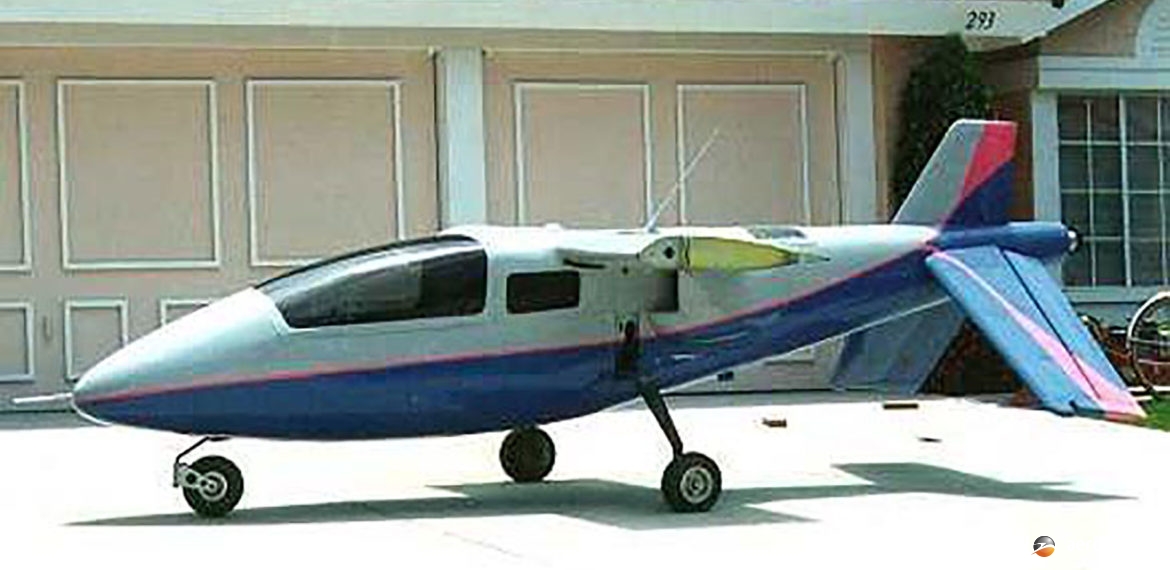Photograph:
A partially complete Taylor Mini-imp (Author’s collection)
Country of origin:
United States of America
Description:
Single-seat high-performance sport aircraft
Power Plant:
One 75 kw (100 hp) Continental O-200 four-cylinder horizontally-opposed air-cooled engine
Specifications:
- Wingspan: 7.77 m (25 ft 6 in)
- Length: 4.87 m (16 ft)
- Wing area: 6.96 m² (75 sq ft)
- Max speed: 322 km/h (200 mph)
- Max cruising speed: 290 km/h (180 mph)
- Economical cruising speed: 209 km/h (130 mph)
- Stalling speed clean: 80 km/h (50 mph)
- Stalling speed landing configuration: 72 km/h (45 mph)
- Rate of climb: 305 m/min (1,000 ft/min)
- Service ceiling: 6,096 m (20,000 ft)
- Range: 805 km (500 miles)
- Fuel capacity: 49 litres (10.8 imp gals)
- Take-off and landing run: 183 m (600 ft)
- Empty weight: 236 kg (520 lb)
- Baggage capacity weight: 23 kg (50 lb)
- Loaded weight: 363 kg (800 lb)
History:
The Mini-Imp was one of a number of designs developed by well-known American designer of light aircraft, Molt Taylor. Taylor was born in Portland, Oregon and was known for designing a number of interesting aircraft, including the XLRQ-1 amphibious assault glider and the Coot.
The Mini-Imp was a second-generation of a 2 + 2 aircraft known as the Taylor Imp (Independently Made Plane) but this model was considered to be too complicated for the amateur constructor and it was decided to scale it down to a single-seat aircraft able to accommodate a variety of engines.
Introduced to the market in 1975, it was a high-wing design with a pusher engine at the end of the fuselage driving via a shaft from the engine located behind the pilot. It had an inverted V-tail. The prototype (N2MB) was flown with a Limbach conversion of a Volkswagen engine. It had a roomy cockpit large enough for heavier pilots. It had a retractable tricycle undercarriage, could use a variety of engines, and was of metal construction. Engines installed have included the Limbach, Turbo Revmaster and Continental O-200. The wings could be folded for ease of storage and trailering. In later years it was marketed and kits became available from Mini IMP Aircraft Co of Weatherford, Texas. More than 350 kits have been sold over the years.
Eventually, to meet the requirements of builders who sought to install the 75 kw (100 hp) Continental O-200 engine, the Model C variant was designed, this having a longer nose (by 30.48 cm – 12 in) and incorporating a larger baggage compartment. This required the installation of an additional vertical fin on the tip of the tail boom to accommodate the longer nose length rather than lengthening the drive shaft. The O-200 engine also required a different propeller and, due to the increased weight of this engine, an up-rated undercarriage.
In 1978, Molt Taylor and Jerry Holcomb began construction of the prototype of a new design known as the Micro Imp, aimed at the market for an alternative to the Quickie aircraft designed by Burt Rutan. This used resin-impregnated, fibreglass-reinforced paper (TPG), in its primary structure. This machine was basically a smaller, lighter version of the Mini-Imp and had a retractable tricycle undercarriage, full-span reflexing flaperons, an NASA GA-PC(1) aerofoil, a two-position propeller and a fully trimmable V-tail. The prototype was powered by a 620 cc Citroen 2CV engine which produced 28 kw (38 hp).
The first Australian example of the Mini-Imp was imported as a kit in November 1976 by Mr John Argall of Glen Iris, VIC, the registration VH-IJA being reserved. Work on its construction commenced the following year. Power plant installed was a Revmaster 2100D. It seems the aircraft was never registered and it is not known if it was completed and flown.
Construction of another Mini-Imp commenced in New Zealand in the hands of James Foster and Peter Newton. This became known as the Kiwi-Imp. Its ultimate fate is not known.
It is not known if any examples have been completed and flown in this part of the world but one aircraft of very similar configuration, which may in fact have commenced life as a Mini-imp, was completed as the Barber HA-1 ZK-FOU (c/n MAANZ/063 – later 409). This was a single-seat all-composite construction aircraft with a mid-mounted engine driving the propeller through a shaft, the propeller being mounted behind the tail. This model, powered by a Rotax 503 engine, was first registered on 11 August 1987 and, other than for a few short hops, was never flown and, after a little testing, was withdrawn from use in July 1995 and is now in the collection of aircraft at the Mandeville Museum in New Zealand.

